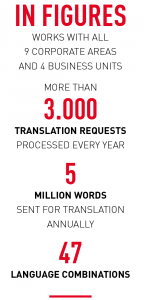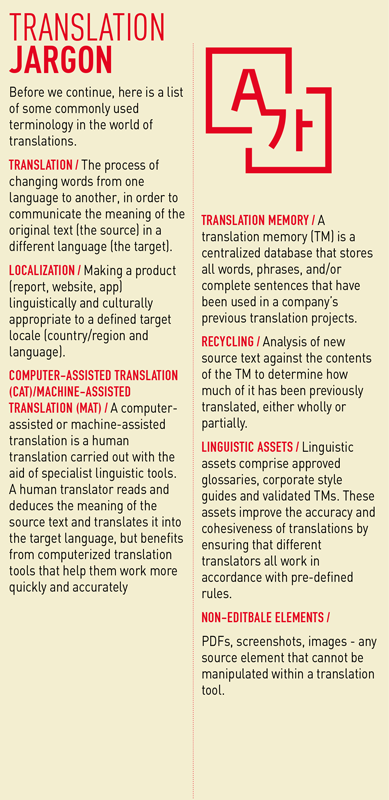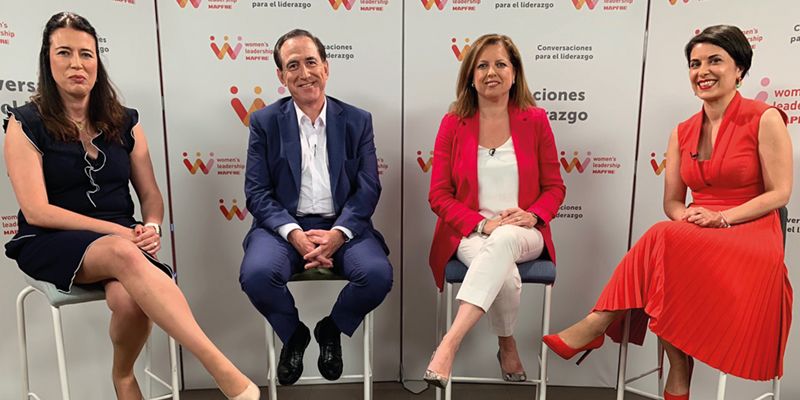MAPFRE’S CORPORATE TRANSLATIONS SERVICE
As MAPFRE continues to become more and more global, the demand for translations is growing every year. So what kind of texts do we translate? Corporate policies, press releases, annual reports, news items for the Global Intranet, internal and external presentations and speeches, training resources, corporate magazines, content for social networks, technology applications, legal and employment contracts, web content for Fundación MAPFRE… the list goes on.
TEXT DONAL RUANE | ILLUSTRATION THINKSTOCK

Following on from the formal adoption of American English and Brazilian Portuguese as corporate languages in December 2012, in addition to Spanish, a decision was taken to create a Corporate Translations Service, tasked with three principal objectives:
• To respond efficiently to MAPFRE’s corporate translation needs
• To reduce costs and delivery times of translations
• To unify and standardize essential terminology
Achieving these objectives initially involved consolidating the number of translation providers working with the MAPFRE Group. After conducting a rigorous public tender, three official corporate providers were chosen, each of whom was selected on the basis of their specific service offering. Centralizing the bulk of our translations needs with just three providers allowed MAPFRE to leverage its purchasing power and negotiate more competitive prices. Each provider works with the same translation memory (TM) and approved corporate glossary and style guide, which ensures faster deliveries and better coherence across all texts sent for translation. Having multiple providers at our disposal also enables us to process large volume jobs on time, as the workload can be distributed among the different providers. This is especially relevant at the start of the financial year when many group companies need to translate their annual accounts and management reports into English, at the same time as MAPFRE S.A. prepares for the Annual General Meeting (AGM), when vast amounts of documentation need to be delivered in our three corporate langauges.

The Translation Process
Naturally, MAPFRE users who request translations are primarily interested in getting their texts translated as quickly as possible, but it’s useful to know what goes on behind the scenes in processing a translation job, so that users are aware of the work flow involved and thereby have a better understanding of how to correctly prepare their files for translation and ensure their translations are delivered when they need them.
The flow chart you see here illustrates the stark difference between most users’ perception of the translation process and the reality of producing a quality translation.
Getting the best translation
So what can you as a MAPFRE user do to make sure your files are correctly translated and delivered back to you in good time? In a word: plan. Planning a translation project properly is the most fundamental step in guaranteeing a quality translation. A professional translator, working with a translation memory (TM), can process up to 2,000 words a day, and it is always advisable to have a single translator process a complete text in order to ensure coherency.
Let’s take a look now at how you can contribute to making sure your source files are processed in the most efficient manner possible:
• Accuracy: review your document thoroughly before sending.
• Clarity: ambiguous or excessively long structures can confuse translators.
• Consistency: double check your document for cohesion and consistency.
• Word choice: try to avoid words with multiple meanings.
• Tone: formal or informal? Make sure your source file language reflects the tone you want in the translation.
• Jargon: if your document includes technical jargon and/ or acronyms, make sure they are clearly explained.
• Format: Your source file must be presented in an editable format. Screenshots, images etc. are not easily localized, and converting them to an editable format results in increased costs and longer delivery times.
Of the points listed above, the last one is the possibly the most important. Many files received for translation include screenshots of a table or graph, and most users are not aware that it is not possible to directly translate these elements. They must first be converted to an editable format, translated and then converted back to their original format and inserted into the finished translation file.
And so, the next time you are preparing a document that will need to be translated, please try to remember to incorporate the translation process into your project schedule. Together we can do anything in any language!

TWO SIGNIFICANT TRANSLATION TRENDS
MACHINE TRANSLATION involves the translation of text by computer, with no human intervention. It originated as a rules-based process, comprising an extensive series of language and grammar rules, supplemented by specialist dictionaries that each focused on specific industries or disciplines.
Nowadays, Neural Machine Translation (NMT) makes machines learn how to translate via a centralized neural network, which effectively comprises multiple processing devices that are modeled on the human brain. NMT offers the best hope of achieving more naturalisticsounding translations.
REAL-TIME CHAT TRANSLATION facilitates the instant translation of chat messages between clients and company agents. This evolving technology enhances the customer journey by ensuring consistency in customer support across multiple languages. Studies show that an online support agent can handle up to four chat interactions simultaneously, as opposed to a single call for a telephone-based support agent, so the efficiencies and potential cost savings for large companies are clear.




